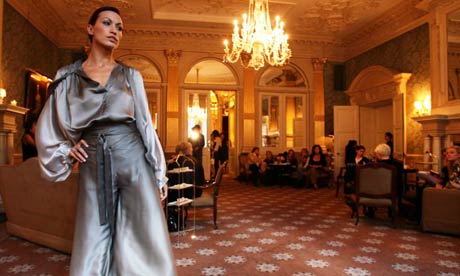
One of Britain's leading fashion designers has reopened the skinny models debate by revealing she struggled to find models big enough to wear the clothes in her latest fashion show.
When Maria Grachvogel set about preparing her catwalk show at Claridge's this week, she requested size 10 models, only to find that most agencies could only provide models size 8 or smaller.
It was stark proof that in the five years since Grachvogel last staged a catwalk show the accepted standard model size has shrunk from an 8-10 to a 6-8. Sarah Doukas, founder of Storm model agency, said earlier this year:"There is no doubt that in the past few years the girls at the top end have become thinner. You'd have to be a fool not to notice it."
"It was tricky finding models in a size 10," Grachvogel, 39, who has a boutique on Sloane Street, west London, and is stocked in around 15 other boutiques, said this week. "Most of the girls we saw were at least a size smaller than that. I make all my samples in a size 10, and it's nice to be able to show them on a body that fills them out.
"I have always been someone who would request that model agencies send me their curviest girls. But this time even they were too tiny to fill a pair of size 10 trousers and make them look great."
Grachvogel's experience adds a designer name to those of supermodels Kate Moss and Karen Elson as part of a growing number of voices from within the industry speaking out against size zero culture. Commenting on her "waif" years to Interview magazine in August, Moss said she "never liked being that skinny".
The same month Elson spoke out in Vogue magazine about the industry's irresponsible attitude to young models. "I remember I came back from a job in Paris and the stylist said to me, have you been eating too many croissants?" she said.
Model agents have pointed to the shrinking size of catwalk samples as the reason why the girls and women on their books have shrunk.
Most fashion designers make their samples using a single "fit model" whose measurements tally with the contemporary catwalk model.
"I prefer not to use a fit model, but instead to make size 10 samples and then try them out on as many women as possible. Most of the women I work with in the studio and shop are a size 8, 10 or 12, and they all try the clothes on. That way, I can find the cut that will fit and flatter most body shapes," Grachvogel said.
Retailers who sell Grachvogel's trousers have dubbed them "magic pants" for their ability to flatter almost all women. "I work with the body, not against it," said Grachvogel, who founded her label in 1994 and counts Angelina Jolie and Marie Helvin amongst her client list. She also designs a budget range of clothes and furniture for online catalogue Oli.
At her Claridge's show the "jabot" - a ruffled organza neckpiece which can turn a simple blouse into an evening look - was being heavily promoted as a tool for credit crunch glamour.
At the side of her catwalk, Grachvogel was pointing out the models she had found with what she calls "a bit of shape". A model sashaying in across the Claridge's drawing room in a satin crepe catsuit caught her eye. "She's got a proper bottom, that one," said Grachvogel approvingly.
Backstory
The spotlight fell on super-skinny models in the summer of 2006 after the deaths of two models - Uruguayan Luisel Ramos and Brazilian Carolina Reston. In September 2006 Madrid fashion week announced that it was to ban models with a BMI of less than 18 from its catwalks. In December 2006 the Italian fashion industry pledged to take a harder line on skinny models but avoided an outright ban.
In 2007 an independent inquiry headed by Lady Kingsmill and backed by the British Fashion Council recommended model health certificates be issued by doctors, a ban on models under 16, and non-smoking and drug-free backstage environments. These suggestions were never put into practice. By August 2008 the British Fashion Council was arguing that it was unworkable to force models to undergo health checks before they took part in London fashion week, and a ban on size-zero models could result in models boycotting London.

